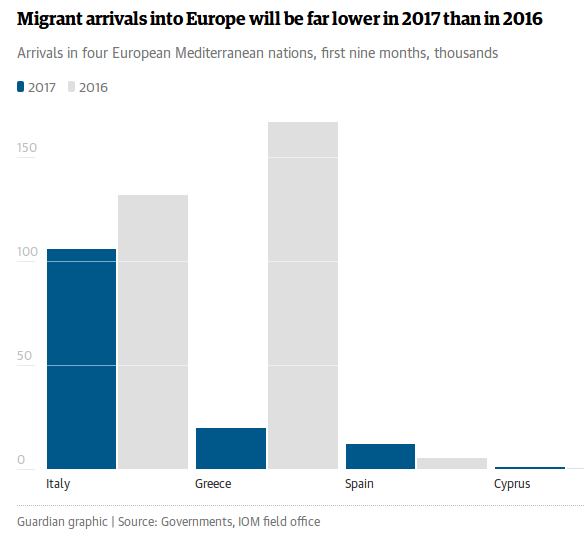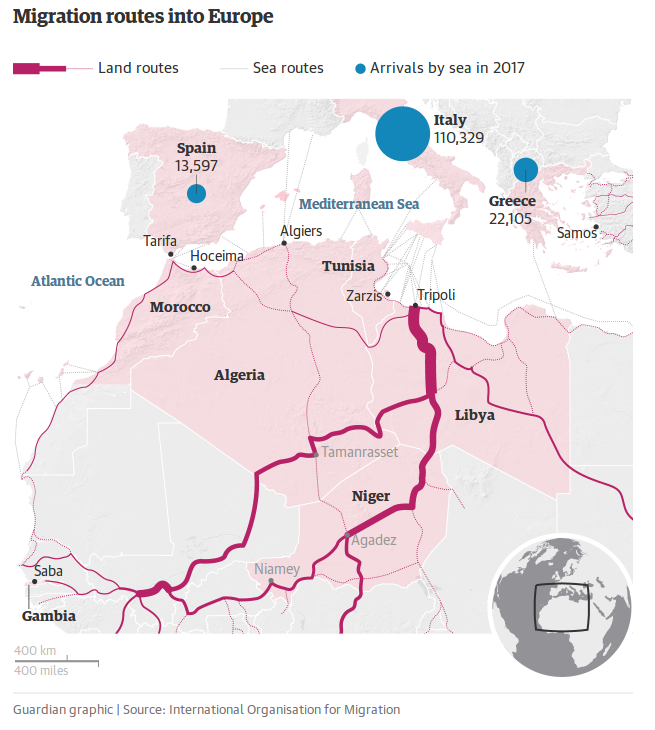The Guardian | 30.10.2017
Fewer people are crossing the Mediterranean, but a nightmarish bottleneck has been created instead
Something happened to the deadly migrant trail into Europe in 2017. It dried up. Not completely, but palpably. In the high summer, peak time for traffic across the Mediterranean, numbers fell by as much as 70%.
This was no random occurrence. Even before the mass arrival of more than a million migrants and refugees into Europe in 2015, European policymakers had been desperately seeking solutions that would not just deal with those already here, but prevent more from coming.
From Berlin to Brussels it is clear: there cannot be an open-ended invitation to the miserable millions of Europe’s southern and eastern periphery.
Instead, European leaders have sought to export the problem whence it came: principally north Africa. The means have been various: disrupting humanitarian rescue missions in the Mediterranean, offering aid to north African countries that commit to stemming the flow of people themselves, funding the UN to repatriate migrants stuck in Libya and beefing up the Libyan coastguard.
The upshot has been to bottleneck the migration crisis in a part of the world least able to cope with it. Critics have said Europe is merely trying to export the problem and contain it for reasons of political expediency, but that this approach will not work.
“We are creating chaos in our own backyard and there will be a high price to pay if we don’t fix it,” said one senior European aid official, who did not wish to be named.
The new hard-headed approach crystallised with the EU-Africa trust fund in November 2015, when European leaders offered an initial €2bn to help deport unwanted migrants and prevent people from leaving in the first place. Spread between 26 countries, the fund pays for skills training in Ethiopia and antenatal care in South Sudan, as well as helping migrants stranded in north Africa return home on a voluntary basis.
Separately the European commission has signed migration deals with five African countries, Niger, Mali, Nigeria, Senegal and Ethiopia. These migration “compacts” tie development aid, trade and other EU policies to the EU’s agenda on returning unwanted migrants from Europe. For instance, in the first year of the compact, Mali took back 404 voluntary returnees and accepted EU funds to beef up its internal security forces and border control and crack down on smugglers.
Detractors say the EU is “bribing” poorer countries to do Europe’s border management. Too much money is said to go to regimes people are fleeing from, such as Sudan. The EU strategy in Libya has also proved controversial, after NGOs found that women and children on the road to Europe had been beaten, raped and starved in the “living hellholes” of Libyan detention centres.
To find out more about the ramifications of this new EU approach, six European newspapers are teaming up this week to report from the region. We will investigate what is happening in Libya, how the bottleneck is driving migrants on to different, less well-travelled routes – and whether the Mediterranean horror is deterring would-be migrants from leaving their homes further south.
:::::
Spiegel Online | 30.10.2017
Kooperation europäischer Medienhäuser: Europas Flüchtlingsrouten
Irgendetwas ist passiert im Mittelmeer im Sommer 2017. Die Flüchtlinge kommen nicht mehr, zumindest nicht mehr in so großer Zahl wie noch im Vorjahr.
Das ist kein Zufall, sondern das Resultat europäischer Politik. Ziel ist es, das Problem dorthin zurückzudrängen, wo es herkommt. Dafür werden Rettungsmissionen im Mittelmeer ausgesetzt. Es werden Hilfsleistungen an afrikanische Länder gezahlt – gegen die Zusicherung, dass Menschen die Ausreise schwerer gemacht wird. Es werden Küstenwachen unterstützt und aufgerüstet: wie in Libyen. Zugleich bleibt die Flüchtlingssituation in anderen Teilen des Mittelmeers extrem angespannt, etwa auf den griechischen Inseln.
Gelöst ist das Problem also keineswegs. Es wird nur verlagert, gerät aus den Augen. Auch in den Medien flaut das Interesse ab.
Um dem entgegenzuwirken, haben sich sechs europäische Medienhäuser zusammengetan. Reporter wurden ausgesandt, um eine Woche lang aus der Region zu berichten: Von Gefangenenlagern in Libyen, über entvölkerte Dörfer in Westafrika, bis zu den überfüllten Flüchtlingscamps in Griechenland. Bis Samstag ist jeden Tag ein anderes Land und ein anderes Medium an der Reihe.
Das ist das Team:
- „Politiken“ (Dänemark)
- „Le Monde“ (Frankreich)
- „El País“ (Spanien)
- „La Stampa“ (Italien)
- „The Guardian“ (Großbritannien)
- „DER SPIEGEL“ (Deutschland)



